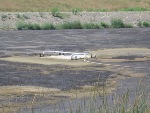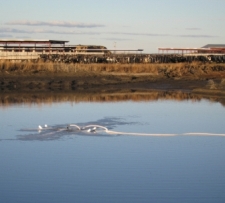
Waste Lagoons: Sloppy Mess or Treatment Opportunity?
- By Chuzhao Lin
- Mar 29, 2011
Waste lagoons have been around for a long time. They serve mainly as storage facilities but also allow for waste treatment to take place. As long as waste lagoons are sized properly, they perform adequately and can be an inexpensive wastewater treatment option appropriate for many applications.
With the development and popularization of concentrated animal feeding operations (CAFOs), waste lagoons are gaining notoriety as pollution sources and are increasingly the targets of stricter regulation, neighbor and abutter complaints, and litigation. This reputation is not completely deserved as new approaches that include surface aeration and microbes enhance lagoon performance and reduce the odor factor as a major deterrent to use.
Aerobic versus Anaerobic Treatment
Broadly speaking, two biological systems are available to treat liquid wastes: aerobic and anaerobic. Aerobic systems employ oxygen to facilitate microorganisms to break down organic wastes into carbon dioxide and water. This approach, while very efficient, can produce large amounts of sludge that can be problematic without further intervention.
Sludge is a combination of recalcitrant material and microbial biomass that grows as it feeds on the large amount of energy that is available in the wastewater. Sludge takes up volume in wastewater treatment systems and periodically needs to be removed, which results in increased operating costs and complexity.
Anaerobic systems, on the other hand, work in the absence of oxygen and also produce carbon dioxide, water, and methane that can be readily converted into energy. Anaerobic systems tend to produce less sludge than aerobic systems for a variety of reasons. When methane is produced, the energy available in the wastewater is stored in the gas. This results in less energy being available for the microorganisms to create biomass, which, in turn, results in less sludge.
The smaller amount of non-methane energy left over in the wastewater means that the anaerobic treatment process needs to rely on different groups of microorganisms to work together. A balance among different groups of microbes is essential or pH balance will become a concern and the anaerobic waste system will break down. Two groups of microbes are especially troublesome: fermenters and methane-producing methanogens. Fermenters are robust and produce volatile fatty acids. These volatile fatty acids then feed into the pathway to produce methane. But methanogens are slow-growing microbes and are sensitive to acidic conditions. When methanogens cannot keep up with the fermenters, volatile fatty acids will accumulate in the system and lower the pH. In turn, methanogens will get inhibited. The vicious cycle will continue until the whole system shuts down.
In general, aerobic treatment systems are used for lower strength wastewater such as residential and municipal wastewater. Anaerobic systems are used for high-strength wastes such as food wastes, animal manure, etc. The anaerobic system also is used to process the sludge from the aerobic system. A combination of both technologies can be used to efficiently treat wastes. If there is sufficient motivation to reduce solid waste disposal cost and create energy through the conversion of biogas, then the combination can be ideal. Typically, the ultimate decision on which approach to use is based on economics.
Incorporating Microbes and Surface Aeration
Waste lagoons have the potential to combine the best features of two systems: efficient waste treatment yet less sludge production. Open to the atmosphere and subject to the elements such as wind, the surface layer of a waste lagoon normally contains sufficient dissolved oxygen in which aerobic microbes can thrive. Underneath the surface layer, the microbes use up dissolved oxygen and the waste lagoon becomes anaerobic. Waste sludge produced from the aerobic process sinks down to the anaerobic layer for further anaerobic treatment to reduce sludge volume.
In waste lagoons holding high-strength wastes such as animal manure, the aerobic layer is greatly reduced and these CAFO lagoons tend to be anaerobic all the way; with oxygen only in the few uppermost millimeters. This type of CAFO lagoon has given waste lagoons a negative reputation that they don’t deserve. In these CAFO lagoons, neither aerobic nor anaerobic treatment process can proceed normally because pH drops and solids start to accumulate in the lagoons. Accumulated solids further reduce treatment volume and the vicious cycle eventually shuts down the waste lagoons as a waste treatment facility. Worst still, sulfate-reducing bacteria thrive in these lagoons and reduce sulfate compounds and produce hydrogen sulfide. Hydrogen sulfide, volatile fatty acids, and other anaerobic degradation products are responsible for the telltale foul odor of CAFO lagoons and a sign that the waste lagoon is in trouble.
One way to alleviate the problem is to introduce surface aeration and aerobic microbes. Both of these aim to restore the aerobic layer that acts as an odor cap for the waste lagoon. A healthy aerobic layer can work synergistically with the anaerobic system underneath. With the addition of surface aeration and aerobic microbes, the restored aerobic layer can siphon off the excess volatile fatty acids. When all steps of the anaerobic system are balanced, solids/sludge will get digested and foul odor minimized.
Although lower strength wastewater is routinely treated with an aerobic system, it can benefit from an enhanced lagoon system. This is because the aerobic system is costly to run: power requirements and sludge disposal are especially expensive. Surface aeration will cut power usage substantially while sludge reduction reduces disposal costs in the enhanced waste lagoons.
Project Case Study: Wagner Dairy
Wagner Dairy of Wisconsin produces more than 13 million gallons of waste a year. The waste is stored in a six-million-gallon lagoon after it is treated in a smaller 500,000 gallon settling pond. Because the dairy is close to several neighbors and it generates a large volume of waste material, it was apparent that the waste lagoon was too small to effectively handle the amount of waste produced.
Three times a day, 300,000 to 400,000 gallons of recycled wastewater is used to flush the barn floor. This water is extracted near the surface of the large waste lagoon and it is essential that there be very low amounts of solids in this recycled wastewater. Prior to the introduction of surface aeration and a microbial mix to the lagoon, thick recycled wastewater caused slippery barn floors and animal injuries. In addition, foul odor was a constant problem with neighbors. During the annual spring and fall pumpouts, when agitation was a must, the additional odor generated caused even more neighbor complaints. This prompted Wagner Dairy to seek a solution and ultimately resulted in the installation of a surface diffuser and the weekly addition of a microbial mix.

Since making the enhancements to the waste lagoon, Wagner Dairy has seen a dramatic reduction in odor and has had virtually no neighbor complaints. Because the resulting recycled water is cleaner, barn floors washed down with it are no longer slippery and animal injuries due to related falls have been eliminated. In addition, bottom sludge in the lagoon is greatly reduced and no longer poses a problem and the farm has been able to eliminate agitation of the lagoon during seasonal pump outs. Instead, they simply use a variable speed hydraulic pump at a low setting to draw out the bottom sludge as needed. The added bonus to the dairy is that they have been able to comply with their nutrient management plan and save money at the same time. Now, only nutrient-rich bottom sludge needs to be hauled away and cleaner lagoon top water can be used to irrigate nearby farm property.
In summary, a combination of surface aeration and microbial mix can restore and enhance the capability of waste lagoons to serve as both a storage and waste treatment facility. Enhanced waste lagoons can be used to reduce sludge generated from waste treatment plants rather than having the sludge disposed of as solid wastes. They can also provide an inexpensive, alternative waste treatment strategy to meet the demand of our society. Enhanced waste lagoons as described in this article can be effectively applied to CAFO waste lagoons as well as residential and municipal wastes to reduce operational and sludge disposal costs.
About the Author
Chuzhao Lin, Ph.D., is director of research at Pro-Act Biotech, a supplier of biological waste treatment systems for the agriculture, food, aquaculture, and oil and gas industries. Dr. Lin can be reached at [email protected].